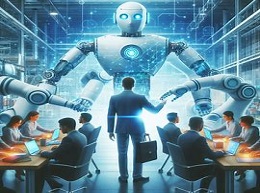AI in Human-Robot Collaboration: Enhancing Workplace Efficiency

Artificial intelligence (AI) is revolutionizing the way humans and robots collaborate in the workplace. By leveraging AI-powered technologies, businesses can optimize workflows, increase productivity, and unlock new opportunities for innovation. In this article, we'll delve into the various applications of AI in human-robot collaboration, examining how it's reshaping industries and redefining the future of work.
Optimizing Task Allocation
AI algorithms can analyze complex datasets and optimize task allocation between humans and robots based on factors such as workload, skillsets, and efficiency. By automating repetitive and labor-intensive tasks, AI enables human workers to focus on higher-value activities that require creativity, critical thinking, and problem-solving.
Example: Amazon's Robotic Fulfillment Centers
Amazon utilizes AI-powered robots in its fulfillment centers to optimize warehouse operations and improve order fulfillment efficiency. These robots work alongside human employees to transport goods, retrieve inventory, and pack orders, allowing workers to focus on tasks that require human intelligence and decision-making.
Enhancing Safety and Ergonomics
AI-enabled robots can enhance workplace safety and ergonomics by performing hazardous or physically demanding tasks, reducing the risk of injuries and improving employee well-being. By automating dangerous tasks, AI helps create a safer work environment for human workers.
Example: Autonomous Vehicles in Manufacturing
In manufacturing plants, autonomous vehicles equipped with AI technology transport heavy materials and equipment safely and efficiently. These vehicles navigate factory floors autonomously, avoiding obstacles and adhering to safety protocols, while human workers oversee operations and perform tasks that require manual dexterity and precision.
Enabling Collaborative Robotics
Collaborative robots, or cobots, are designed to work alongside human workers in a shared workspace, performing tasks collaboratively and safely. AI algorithms enable cobots to adapt to dynamic environments, learn from human demonstrations, and adjust their behavior in real-time to optimize collaboration and efficiency.
Example: Universal Robots' UR5e Cobot
Universal Robots' UR5e cobot is equipped with AI capabilities that enable it to perform a wide range of tasks, from assembly and packaging to machine tending and quality inspection. These cobots can work alongside human operators without the need for safety cages, enhancing flexibility and productivity in various industries, including manufacturing, healthcare, and logistics.
Facilitating Human-Robot Interaction
AI technologies such as natural language processing (NLP) and computer vision enable seamless communication and interaction between humans and robots in the workplace. By understanding and responding to human commands and gestures, AI-powered robots can collaborate more effectively with human workers.
Example: Rethink Robotics' Sawyer Robot
Rethink Robotics' Sawyer robot is equipped with advanced AI algorithms that enable it to understand and respond to natural language commands from human operators. This enables intuitive human-robot interaction, allowing workers to program and control the robot easily without extensive technical expertise.
Driving Innovation and Agility
AI-powered human-robot collaboration fosters innovation and agility in the workplace by enabling rapid adaptation to changing business needs and market demands. By deploying flexible and adaptive robotic systems, businesses can stay competitive in dynamic and fast-paced industries.
Example: Agility Robotics' Digit Robot
Agility Robotics' Digit robot is designed to navigate complex indoor and outdoor environments, performing a variety of tasks such as package delivery, inventory management, and facility inspection. Its AI-driven navigation system allows it to traverse diverse terrains and obstacles safely, enabling businesses to adapt to evolving customer demands and operational requirements.
Artificial intelligence is revolutionizing human-robot collaboration in the workplace, unlocking new levels of efficiency, safety, and innovation. By leveraging AI-powered technologies, businesses can optimize task allocation, enhance safety and ergonomics, and facilitate seamless interaction between humans and robots. As AI continues to evolve, the potential for enhancing workplace efficiency and productivity through human-robot collaboration is limitless, paving the way for a future where humans and robots work together synergistically to achieve shared goals.